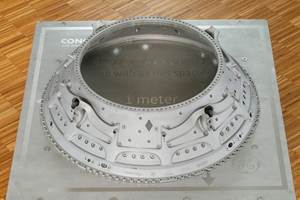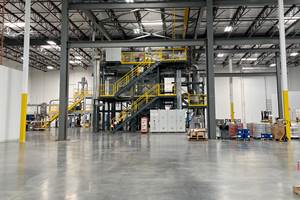3D Printing With Recycled Powders: Reducing Waste and Material Costs
Can you print high-quality parts using recycled thermoplastic powder? JawsTec saves 2 tons of waste per year by investing in SLS printers that reuse scrap to make new parts.
Share
JawsTec acquired four Nexa3D QLS 230 SLS machines to meet its goals of increasing 3D printing capacity while also reducing its overall waste. These machines are able to produce high-quality parts with a mix of new and recycled powder. Source (all photos): JawsTec
To meet sustainability goals, more and more companies are looking for ways to recycle or reuse manufacturing scrap, including the thermoplastic powder left over from 3D printers.
But this also has to be economically feasible in the long term. So unless the 3D printing is done near a facility that can recycle or reuse this material, what is the most sustainable option that will also save money?
For one company, the solution was to invest in 3D printers that could recycle scrap from its other 3D printers to make new components — allowing the company to grow its business, reduce waste to landfill, and save materials costs all in one shot.
JawsTec is a manufacturing service provider in American Falls, Idaho that is, according to co-founder and CEO Oscar Klassen, “mostly focused on polymer 3D printing, with CNC machining as another smaller portion of the business.”
Founded in 2018, the company currently operates 16 industrial 3D printers — including selective laser sintering (SLS) systems from EOS, Multi Jet Fusion (MJF) systems from HP, and, most recently, QLS 230 and QLS 820 SLS machines from Nexa3D.
JawsTec provides services for prototyping through volume production of parts in a range of industries, from components for agriculture and industrial food production to aerospace and automotive prototypes. Among the company’s customers to date are Tesla, Apple, BMW, Ford, Delta and SpaceX.
Klassen says, “We have an instant quoting platform that makes it simple and quick for customers to get into this space and set expectations. We are able to get our customers higher quality parts competitive to those made with injection molding as far as strength and quality, and also cheaper for prototyping and small production runs.”
After achieving initial successes, the company’s main focus became growing its range of machines to accommodate more customers. At the same time, Klassen says that reducing manufacturing scrap — especially the excess powder produced from polymer printers — was a growing concern.
With its legacy SLS and MJF machines, the company had to dispose of up to 30% of its total thermoplastic powder, amounting to more than 2 tons of waste per year that needed to be stored and ultimately shipped to a landfill at JawsTec’s expense.
“This was high-quality, usable powder coming off these machines, but we didn’t have a way to use it,” Klassen says. He notes that while some larger companies may be able to find uses for the material or ship it back to a materials supplier for them to recycle, for smaller companies and service bureaus like JawsTec, recycling waste powder generally isn’t economically feasible.
So, the company had multiple goals when looking for its next machines to invest in: growing JawsTec’s printing capacity, providing an in-house solution for its current powder waste, and saving on disposal costs.
This search led to Nexa3D’s latest QLS 230 machine, a small-format SLS machine developed with the capability of running on either virgin or a combination of virgin and recycled thermoplastic powder.
JawsTec ultimately invested in four of these machines, as well as one larger Nexa3D QLS 820 machine.
Addressing Recycling and Sustainability in 3D Printing
The QLS 230 machines at JawsTec’s shop are used to produce small production runs of parts for recreation, automotive or agricultural applications.
The QLS 230 is an open platform, industrial SLS printer with a build volume of 9 x 9 x 9 inches, said to provide 24-hour cycle speeds with one single-watt laser. It is compatible with recycled powders from SLS and MJF printers, as well as a range of virgin thermoplastic materials.
Lewis Simms, chief marketing officer at Ventura, California-based Nexa3D, explains that the machine was developed to provide customers with a “zero-waste” printing option. He says, “Taking waste powder from other printers and leveraging it to make new, good parts is a huge win not only from a sustainability perspective, but from the economics of the process as well, lowering the cost per part. Before coming to Nexa3D I worked at a service bureau, and I know firsthand that thermoplastic powders aren’t inexpensive. So, it’s a double win.”
However, from a supplier perspective, it’s worth noting that developing systems to use more sustainable materials like recycled or bio-based polymers isn’t the only solution being worked on to address sustainability in 3D printing.
Simms emphasizes that it’s important for 3D printer suppliers to address sustainability not only from a materials perspective — which decreases the carbon footprint for the customers using the printers — but from a systems perspective, or the level of Nexa3D’s own printer manufacturing. “For our own printers, we looked at materials reduction in the printer manufacturing itself. We have printers like our XiP and XiP Pro that are purposefully built from recyclable materials like aluminum, for example, to reduce consumables. Additionally, over 80% of the power is directly for part production. The printer itself is quite energy efficient,” he says.
Recycled Powder SLS in Action
How does a machine like the QLS 230 work in practice for a customer?
Klassen explains that JawsTec is now able to save the excess powder from its other printers, combine this with virgin material — the current ratio is just under 80/20 new powder to recycled — and print new parts for customers.
The ratio of new to recycled powder was an initial trial and error process, as JawsTec aimed to use as much recycled material as possible without sacrificing part quality. “If you were to use only recycled powder without adding any virgin material at all, the part would become very fragile, almost like paper, and would just crack and break,” Klassen says. “At this 80/20 ratio, we’re seeing high-quality parts coming off the machine.”
The smaller build volume of the machine — compared to for example 13.7 x 13.7 x 15.7 inch build volume for JawsTec’s QLS 820 — combined with its relatively lower-power laser and recycled material content suit it for prototyping or small production runs.
Another benefit to the printer is fast printing cycles. Simms explains, “The printer is geared for about a 24-hour total cycle time, meaning you’re able to turn around a build per day including cooldown, which means it’s a much shorter cooldown time than you typically see with SLS, thanks in part to the smaller build volume. In comparison, most SLS printers can take up to several days per build just to cool down.”
Klassen adds, “These machines would be good on their own, because you can use new powder in them, too, but it’s especially beneficial when you pair them with existing machines that you can recycle powder from.”
JawsTec is able to sell parts produced with the QLS 230 for a lower price — “we’re getting the recycled material at no cost, so that’s less material cost we have to factor into the pricing, and that makes it very competitive, especially for customers who may be new to 3D printing and wanting to try it out for the first time,” Klassen says.
According to Simms, “A lot of sustainability initiatives come at a higher cost to the company. A solution like this enables a company to lower its carbon footprint while also benefiting its own business financially.”
End markets this has been used for include the recreational market, including parts for RC cars, as well as some automotive and agriculture customers. “It really depends on what the end goal is, be it a part with the highest possible strength or lowest possible cost, or made with sustainable materials. This is the printer we use when a customer prioritizes low part costs and sustainability,” Simms says.
So far, the company says it has saved more than 2 tons of powder from landfill, while reaching its capacity goals and nearly doubling production output.
Simms emphasizes that there’s still much more to be done in the industry to enable truly sustainable manufacturing practices. “We’re making good strides toward putting more sustainable practices in place, but the additive industry has so much farther to go.”
Related Content
3D Printed Heat Exchanger Illustrates Siemens' CATCH and Release Approach
Solutions for energy efficiency, sustainability, part repair and more are developing at Siemens’ Charlotte Advanced Technology Collaboration Hub (CATCH) in North Carolina.
Read MoreGE Additive Helps Build Large Metal 3D Printed Aerospace Part
The research is part of an initiative to develop more fuel-efficient air transport technologies as well as a strong, globally competitive aeronautical industry supply chain in Europe.
Read MoreMachine Tool Drawbar Made With Additive Manufacturing Saves DMG MORI 90% Lead Time and 67% CO2 Emission
A new production process for the multimetal drawbar replaces an outsourced plating step with directed energy deposition, performing this DED along with roughing, finishing and grinding on a single machine.
Read MoreMultimodal Powders Bring Uniform Layers, Downstream Benefits for Metal Additive Manufacturing
A blend of particle sizes is the key to Uniformity Labs’ powders for 3D printing. The multimodal materials make greater use of the output from gas atomization while bringing productivity advantages to laser powder bed fusion and, increasingly, binder jetting.
Read MoreRead Next
How Avid Product Development Creates Efficiencies in High-Mix, Low-Volume Additive Manufacturing
Contract manufacturer Avid Product Development (a Lubrizol company) has developed strategies to streamline part production through 3D printing so its engineering team can focus on development, design, assembly and other services.
Read MoreCarnegie Mellon Helps Industry, Students Prepare for a Manufacturing Future with AM and AI
Work underway at the university’s Next Manufacturing Center and Manufacturing Futures Institute is helping industrial additive manufacturers achieve success today, while applying artificial intelligence, surrogate modeling and more to solve the problems of the future.
Read MorePostprocessing Steps and Costs for Metal 3D Printing
When your metal part is done 3D printing, you just pull it out of the machine and start using it, right? Not exactly.
Read More.jpg;width=70;height=70;mode=crop)







.jpg)






